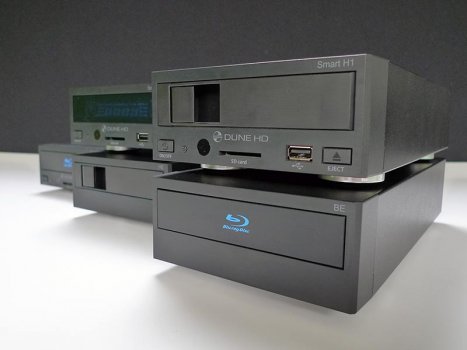 Last time we put a HDi Dune media streamer through the DigitalReviews process we ended up giving away a coveted Editor’s Choice Award. And so it is with great expectations that we take a look at HDi Dune’s new Smart Series lineup: The Dune HD Smart D1, Smart B1, Smart H1 and the BE and HE Smart extension units.
Last time we put a HDi Dune media streamer through the DigitalReviews process we ended up giving away a coveted Editor’s Choice Award. And so it is with great expectations that we take a look at HDi Dune’s new Smart Series lineup: The Dune HD Smart D1, Smart B1, Smart H1 and the BE and HE Smart extension units.
Read on for our review.
The Smart series is a completely new take on the Media Streamer segment with its modular component nature. The series is made up of three head units (B1, H1 and D1) and three extension units (BE, HE and ME). While the three Smart head units are all fully functional media streamers, their physical differences provide a particular added functionality.
– The Smart B1 has an integrated BluRay drive.
– The Smart H1 has an integrated hot swappable HDD tray.
– The Smart D1 has a digital display along with space for an internally fitted HDD.
This allows the user to choose the specific Smart head unit that best matches their particular needs.
Similarly, the extension units allow users to easily upgrade their head unit’s capabilities to their exacting needs.
– The BE extends the head unit with an external Bluray drive.
– The HE extends the head unit with an external hot swappable hard drive.
– The ME extends the head unit by providing space for two Dune expansion boards (not reviewed).
The extension units have been specifically designed to connect to the head units and provide a seamless experience when connected. Having all six units match in dimension, design and experience, makes the Smart series look great and promise much.
First Impressions
The biggest gripe we had with the BD Prime 3.0 was its overall look and feel. Specifically, we didn’t agree with some of the outward design choices: The “rather large (and very blue)” Bluray logo and the “obtrusive” product labelling on the front face, for example.
As soon as we pulled out one of the new Smart units we were almost lost for words. We then pulled out another. And another. Not only have Dune toned down the labelling, but workmanship, look and feel on these new units was simply phenomenal.
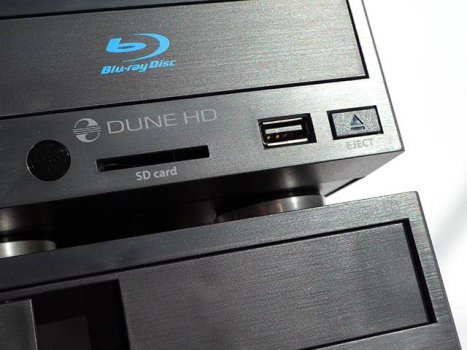 As the images have already given away, the Smart series is without doubt the most elegant media streamers we have ever seen. Period.
As the images have already given away, the Smart series is without doubt the most elegant media streamers we have ever seen. Period.
From the neatly listed logos on the top right of each unit to the now /unobtrusive/ grey product labelling, the units look great. The brushed aluminium front faces are top notch and the metal cases have that “hi-fi unit component” look to them. The plastic power and eject buttons match suitably as do the Bluray/Hard Disk Trays. The Bluray logo is still loud, but on the otherwise understated B1 and BE units, we like it.
Incidentally, with the exception of their main feature (Bluray drive; hot swappable HDD tray and LCD screen respectively), the B1, H1 and D1 all have identical front faces (from left to right): Power button, LED, Infra-red receiver window, SD Card slot, USB port and Eject button.
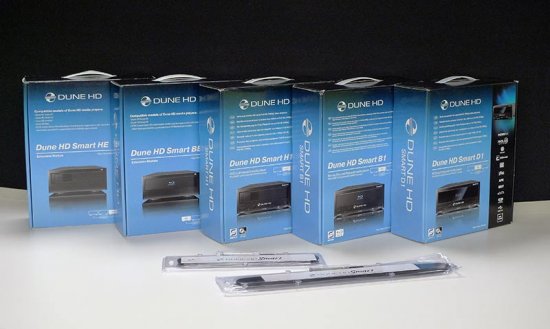 Like the front, the rear of the the three media player head units are well organised and feature everything you would expect from a modern media streamer:
Like the front, the rear of the the three media player head units are well organised and feature everything you would expect from a modern media streamer:
– 10/100Mbit Ethernet Port
– Two (rear) USB ports
– Composite Connections
– Component Connections
– HDMI port
– eSATA port
– TOSLINK Optical Out port
– Mains Power Switch
– Dedicated Bus connector (for future external devices)
– 12V DC IN
Additionally, the H1 and D1 feature a USB B (slave) port for direct connection to a computer.
All three head units feature identically located (and sized) vents on the top and the entire Smart Series feature silver, rubber footed, feet. It might seem trivial but in our experience, the amount of effort that has been put into a component’s feet tends to be a fairly good indicator of its overall attention to quality.
While the 142mm x 276mm x 65mm dimensions (including legs) of the Smart units look great, there’s been a lot more thought behind it than meets the eye. HDi Dune sells special fastening brackets that allows three units (or just two) to be joined horizontally to form one super unit. And it’s no accident that the three unit super unit just so happens to be about the size of a bonafide Hi-Fi component. Clever.
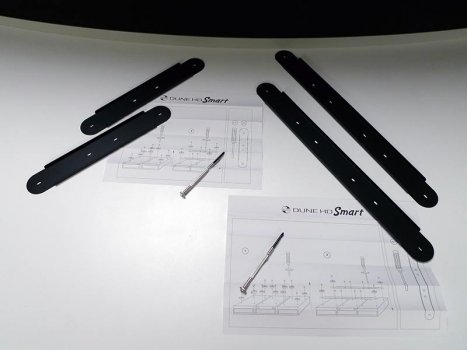 While both the two and three unit brackets worked well enough, we’re not entirely sold on them from an aesthetic or even practical point of view. We’re sure someone out there will appreciate the option – and good on Dune for providing it – but we reckon a good ol’ vertical stack of Smart units is probably the way to go, aesthetically at least.
While both the two and three unit brackets worked well enough, we’re not entirely sold on them from an aesthetic or even practical point of view. We’re sure someone out there will appreciate the option – and good on Dune for providing it – but we reckon a good ol’ vertical stack of Smart units is probably the way to go, aesthetically at least.
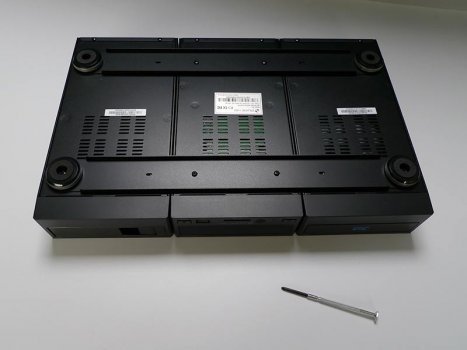
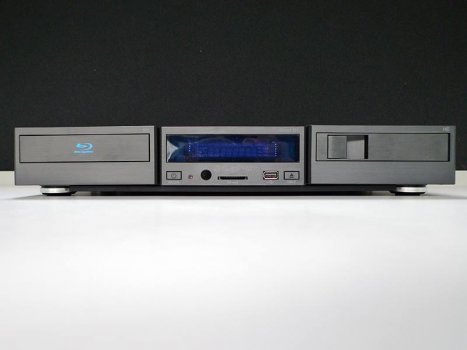 Ironically, where the flashy rendered BD Prime 3.0 images created somewhat of a visual let down upon unboxing, the Smart series actually look *better* in real life than in their cleaned up marketing images!
Ironically, where the flashy rendered BD Prime 3.0 images created somewhat of a visual let down upon unboxing, the Smart series actually look *better* in real life than in their cleaned up marketing images!
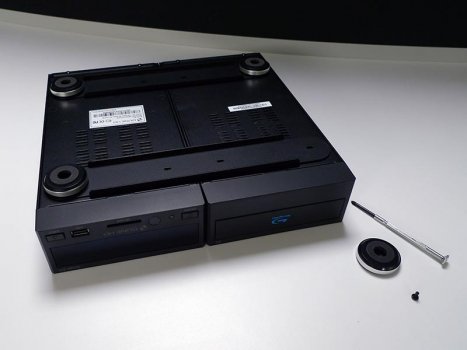
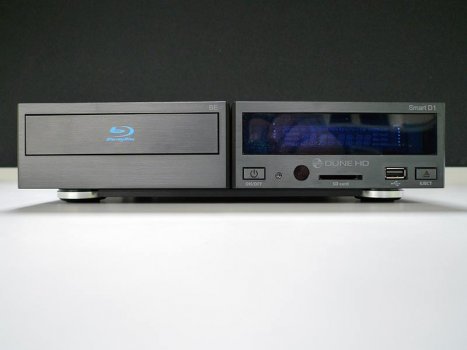 The BE and HE extensions completely match the design of their media player cousins – right down to the grey BE/HE labels in the top right corner. Connecting a BE unit to either a Smart D1 or Smart H1 instantly adds Blu-Ray media playback capability to your existing head unit. Similarly, the HE unit adds a hot swappable HDD drive to your existing head unit for storage or extra storage if you are connecting it up to a D1 (with HDD installed) or a H1.
The BE and HE extensions completely match the design of their media player cousins – right down to the grey BE/HE labels in the top right corner. Connecting a BE unit to either a Smart D1 or Smart H1 instantly adds Blu-Ray media playback capability to your existing head unit. Similarly, the HE unit adds a hot swappable HDD drive to your existing head unit for storage or extra storage if you are connecting it up to a D1 (with HDD installed) or a H1.
The rear of the extension units is minimal but purposeful. The H1 has a number of ports to provide connectivity to your PC or Smart Series head unit: Two USB ports, an eSATA port and a USB slave port. Additionally the rear of the H1 features the same power switch as the head units as well as a 12V DC in port.
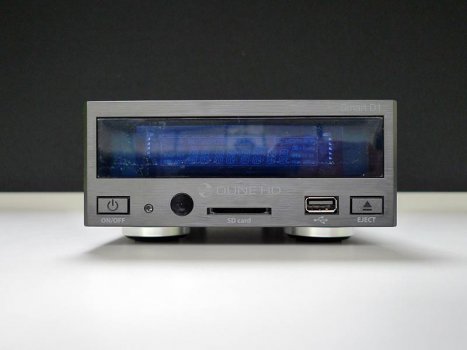
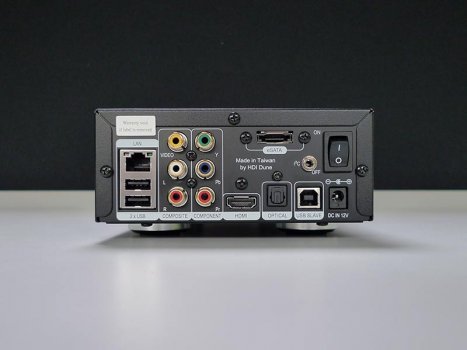
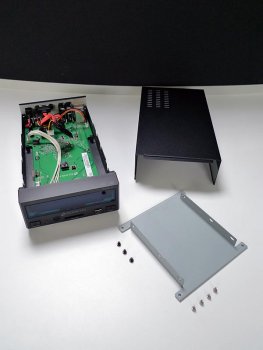 The BE unit is a little more sparse. Along with the standard power switch and the 12V DC in ports, the only other connection adorning the rear of the BE unit is its lone eSATA port. We would’ve liked to connect this unit up to our MacBook Pro but alas, no dice.
The BE unit is a little more sparse. Along with the standard power switch and the 12V DC in ports, the only other connection adorning the rear of the BE unit is its lone eSATA port. We would’ve liked to connect this unit up to our MacBook Pro but alas, no dice.
The only Smart Series unit not tested was the ME extension unit which is essentially a unit created for future extensibility. We’ll come back to this a little later.
In the box
As has been the trend, all three head units come with pretty much identical accessories. Both the B1, H1 and D1 come with a short length of HDMI cable, a set of standard A/V RCA cables, a quick start guide, an external power supply (with foreign three prong power cable), and a short user manual and identical remotes (with 2xAAA batteries).
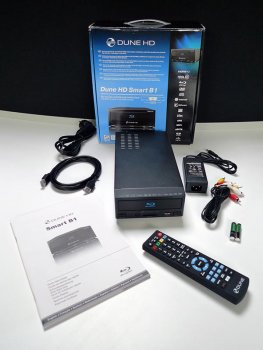
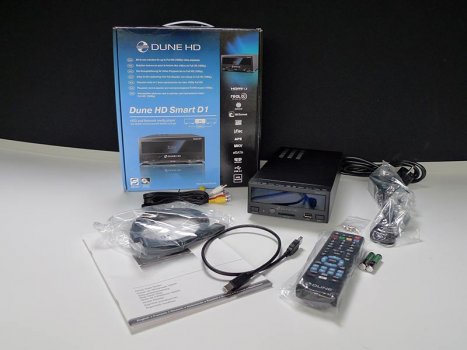
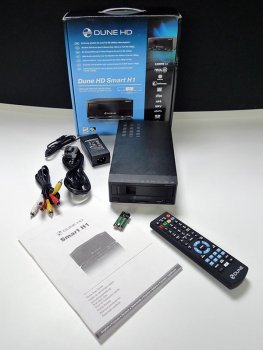 With its internal hard drive and Slave USB port, both the H1 and D1 packages included an additional USB A to USB B cable for connecting the unit to a computer.
With its internal hard drive and Slave USB port, both the H1 and D1 packages included an additional USB A to USB B cable for connecting the unit to a computer.
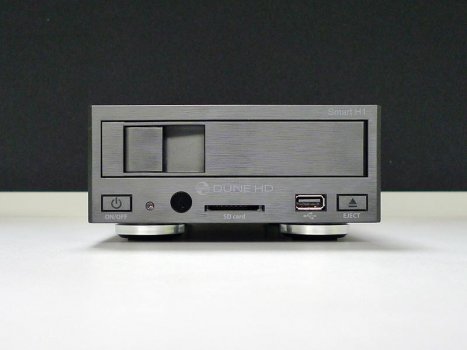
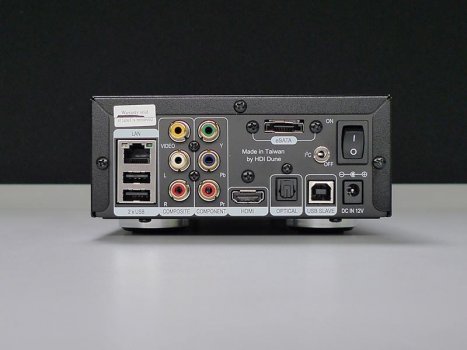
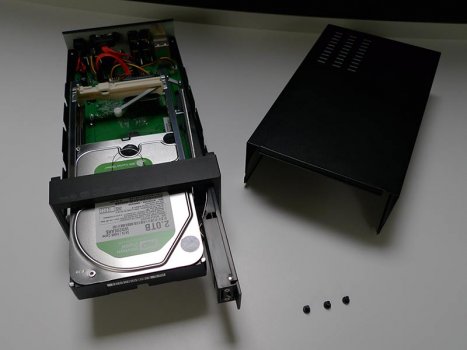
Unlike the previously reviewed BD Prime 3.0, the Smart series’ smaller footprint has resulted in the need for an external power brick. The brick isn’t very large and international customers will be glad to know that the brick has the fairly standard three prong PC power connector on it. It is worth noting, however that each component requires its own individual power brick – including extension units.
The remote control included in all three packages was also identical and coincidentally, nearly identical to the one included in the BD Prime 3.0 package, twelve months earlier. In fact, the layout and feel of the Smart Series remotes is identical to the BD Prime 3.0’s remote with two minor differences: Where the BD Prime had REPEAT and SHUFFLE/PIP buttons, the B1/H1/D1 remote now have a RECord and a button containing the HDi Dune Logo.
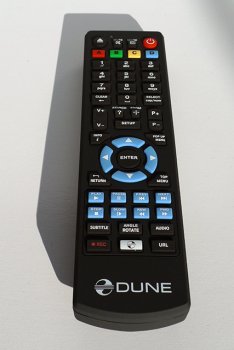 Thankfully, the new Smart Series remotes also have the same “velvety, slightly soft and rubbery plastic” feel as the old remote which we still get a little excited about. After many months of using the original BD Prime remote, we can attest that despite its lack of bells and whistles, it is still one of the most comfortable and user friendly remotes we have ever used.
Thankfully, the new Smart Series remotes also have the same “velvety, slightly soft and rubbery plastic” feel as the old remote which we still get a little excited about. After many months of using the original BD Prime remote, we can attest that despite its lack of bells and whistles, it is still one of the most comfortable and user friendly remotes we have ever used.
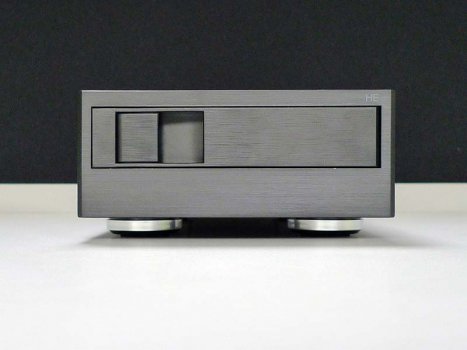
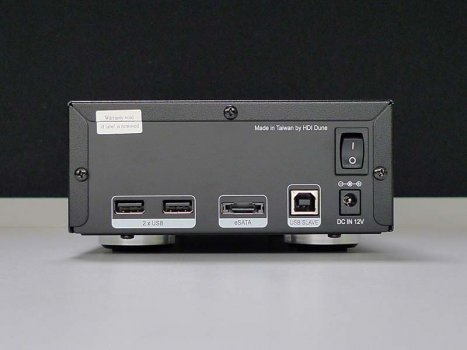
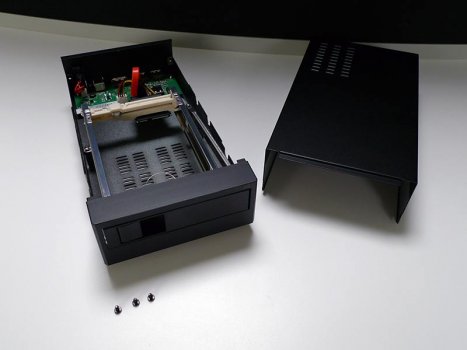
Unlike the head units, the BE and HE units contain less cables and accessories. Along with a manual and power brick/cable, the HE package contained a short length of eSATA cable as well as a USB A to B cable.
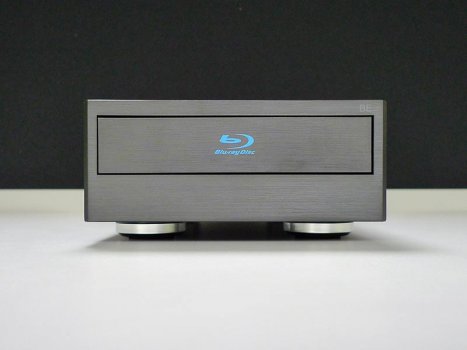
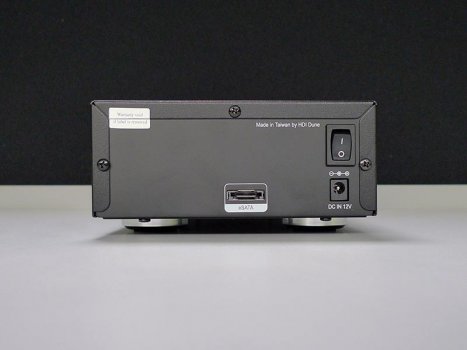
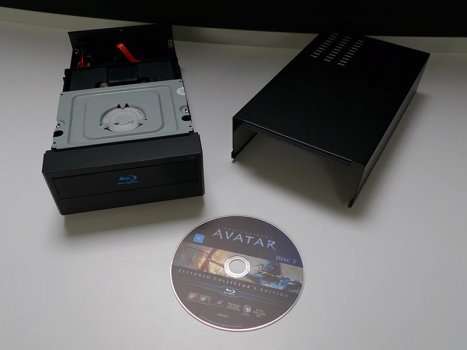 The BE package contained the same power cables and brick but as it’s rear panel predicted, the only cable included was a short length of eSATA.
The BE package contained the same power cables and brick but as it’s rear panel predicted, the only cable included was a short length of eSATA.
Usage
Bar some minor changes in the firmware, the media player functionality of the Smart Series proved to be essentially the same as the Dune BD Prime 3.0 reviewed last year.
As we did with the previous review, we tried a variety of media (Mostly MKV and AVI) with all the Smart units and beyond the playback of FLV files, had no real issues. We also gave the occasional WMV and TS file a run and again; no issues. Like the BD Prime 3.0 before it, the general breadth of file playback of the Smart Series was most impressive.
High bitrate remux Bluray files (in excess of 40Mbps peak), as well as full Bluray ISOs (both images and Bluray folder structure) were tested and all played without issue, from internal, external and network sources. Full Bluray menus worked well and the picture quality across the board was nothing but superb as expected.
Physical Bluray discs played back using the B1 or via one of the other Smart players in conjunction with the BE extension unit also worked flawlessly. During Bluray playback the physical Bluray drive was acceptably quiet, although the initial crank when the drive opened (and closed) does take some getting used to.
January 2011 update: It’s been brought to our attention that there may have been some confusion with regards to the Smart Series’ ability to play back Bluray 3D. While the units do sport RealD technology, they simply do not have the hardware for playing back 3D Bluray content. As of writing, no media player (other than dedicated Bluray players, obviously) are able to play Bluray spec 3D content. 3D Bluray capability is slated to hit media players everywhere when the just announced Sigma Designs 8190 chip becomes available late 2011.
Out of all formats tested, FLV files continued to be the only format that the BD Prime 3.0 flatly refused to play.
With no active cooling in any of the units, we were sure to check on heat levels and at no time did any of the units give us cause for concern, during playback or marathon file transfer sessions.
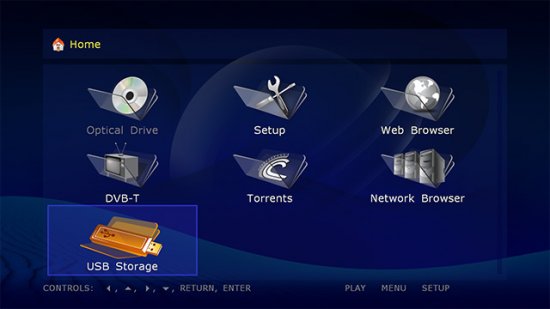 We are also pleased to report that the occasional audio sync issues we encountered with the older BD Prime 3.0 unit were not exhibited by any of the new players tested – at all. Considering the near identical hardware specs, we would suggest firmware updates are responsible for this improvement.
We are also pleased to report that the occasional audio sync issues we encountered with the older BD Prime 3.0 unit were not exhibited by any of the new players tested – at all. Considering the near identical hardware specs, we would suggest firmware updates are responsible for this improvement.
Also present in the current firmware is a handy online update checker which we missed in the previously tested BD Prime 3.0 firmware. And that’s not the end of it, future firmware will incorporate code to allow this iPhone app to control Dune players via wifi. Who needs an RF remote?
Coupled with the user voting firmware concept – where users have an active say in what direction future firmwares take – we’d say that firmware development is relatively strong and in touch with their userbase.
While we tend to concentrate on the video playback capabilities, like the BD Prime 3.0, the Smart Series peripherally support IPTV, Internet Radio support, Torrent Client and photo viewing. Also new to the Dune firmware is a rudimentary Web browser which worked, although somewhat clunkily via the media centric remote control.
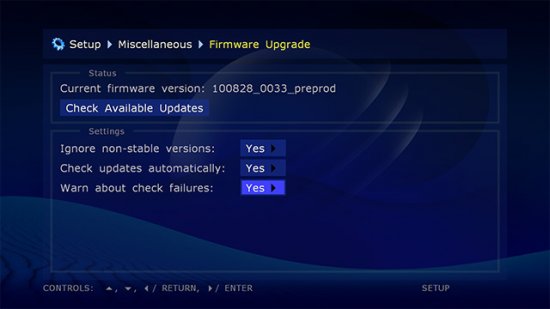 Interoperability between the individual modules however, was much like connecting external drives to a modern PC. Where we connected the BE unit via eSata (cable included), we ran the HE via USB. Whenever an extension unit was connected to a head (playback) unit, the unit appeared on screen automagically. This modular system was just like the marketing suggested. Once power was applied and a data connection (USB/eSATA) was made, everything just worked the way you expected it to.
Interoperability between the individual modules however, was much like connecting external drives to a modern PC. Where we connected the BE unit via eSata (cable included), we ran the HE via USB. Whenever an extension unit was connected to a head (playback) unit, the unit appeared on screen automagically. This modular system was just like the marketing suggested. Once power was applied and a data connection (USB/eSATA) was made, everything just worked the way you expected it to.
When using an internal hard drive in the H1 and D1, we found copying and general file transfer performance to be acceptable. When copying from an external USB hard drive to the internal one, we achieved an average of around 22MB/s – as reported by the unit itself. Using the HE extension unit with a similar HDD resulted in similar results.
When using the Smart H1/D1/B1 interface to copy files, a rather detailed information screen is presented, covering time elapsed, time till completion, file sizes, etc. All our file transfer tests worked without issue.
Ironically, the only concern we had with the whole file management experience was with regards to that informative transfer screen. While copying, we found that the information screen remained on screen throughout, overriding any screen saver settings we had. We’re kind of precious when it comes to our Kuro, so we switched our set off during an extended file transfer to avoid even the possibility of any burn in occurring. Firmware should solve this minor problem, we think.
 Using the H1/D1 as slave USB drives was a cinch also: As soon as the slave USB connection was made, the unit connected instantly began behaving like any other external USB HD enclosure. As soon as it was unplugged, the media player returned. Easy.
Using the H1/D1 as slave USB drives was a cinch also: As soon as the slave USB connection was made, the unit connected instantly began behaving like any other external USB HD enclosure. As soon as it was unplugged, the media player returned. Easy.
All in all, there aren’t many real negatives to speak of. Beyond the minor transfer screen issue, the two things that did present themselves were the slightly inconsistent on screen display experience and the general wait time when starting/stopping file playback.
While the onscreen display is generally quite good – the menus and file browsing screens are both neat and well designed – the information screens (time seek, file transfers, etc.) feel less graphic and more text based than the rest of the interface. Beyond this, the information screens when playing back Bluray (physical discs or images) is a different style to that of the regular video media playback screens. While this isn’t a deal breaker – we like to watch movies, not browse/look at information about them – the lack of consistency is unbecoming of players that look so sheik and well designed on the outside.
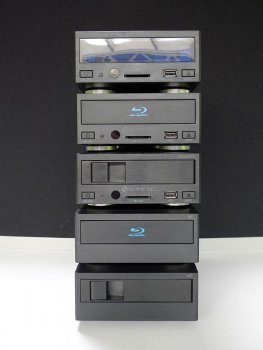 The wait time between commands – mainly between file play and actual on screen playback – might not be all that long but as with the BD Prime 3.0, the time spent looking at a black screen just feels slightly too long. We’re not sure if this is a Dune firmware issue or some kind of incompatibility with our Kuro monitor but we can’t help but think this could do with some improvement. Again, not a deal breaker but worth noting.
The wait time between commands – mainly between file play and actual on screen playback – might not be all that long but as with the BD Prime 3.0, the time spent looking at a black screen just feels slightly too long. We’re not sure if this is a Dune firmware issue or some kind of incompatibility with our Kuro monitor but we can’t help but think this could do with some improvement. Again, not a deal breaker but worth noting.
The Future
In another twist, HDi Dune have designed the Smart series to be hardware upgradable. As new Sigma Designs processors are released, owners of Smart Series head units will be able to return their units to authorised resellers and have them upgraded at a minimal cost.
With the new Sigma Designs 8646 chips slated for an early 2011 release (and touted as the first available upgrade), HDi Dune has essentially leapfrogged the competition by future proofing their current units.
Dune were kind enough to supply five of six Smart series units for this review with the missing unit, being designated the Smart ME. The ME will match the style and dimensions of the other units and will allow the housing of up to two boards for further extending the features of the Smart Series.
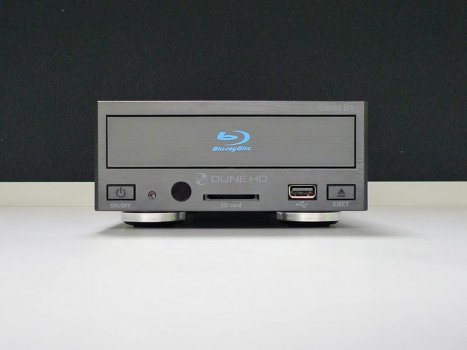
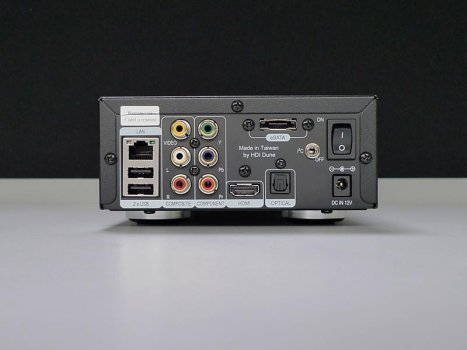
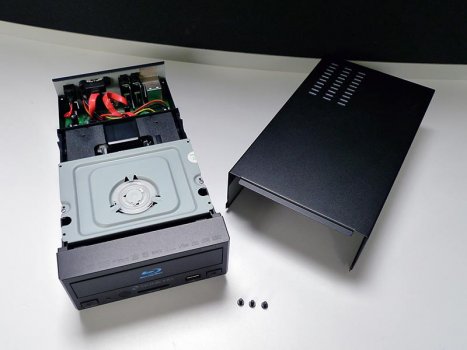
While there is little solid information available, we understand that the first extension boards will most likely be of the DVB-T tuner variety, with talk of dual DVB-T/T2/C compatible tuners hitting shelves in early 2011.
Considering the strong exterior look of the Smart Series, we think maintaining the internals of these units over time (and investing in extension units) might actually be an effective strategy.
Specifications – B1
• Processor: Sigma Designs 8642
• RAM: 512 MB
• Flash memory: 128 MB, expandable with a HDD partition, USB flash drive, or SD card (2GB recommended)
• Media sources: built-in Blu-ray drive, external HDD (USB, eSATA), external optical drive (USB, eSATA), USB devices (USB flash drive, USB card reader, etc), built-in SD card reader (SD/SDHC), PC and NAS in local network (SMB, NFS, UPnP, HTTP), other Internet and local network media sources (HTTP, multicast UDP/RTP)
• Video codecs: MPEG2, MPEG4, XVID, WMV9, VC1, H.264; support for very high bitrate video (up to 50 MBit/s and higher)
• Video file formats: MKV, MPEG-TS, MPEG-PS, M2TS, VOB, AVI, MOV, MP4, QT, ASF, WMV, Blu-ray-ISO, BDMV, DVD-ISO, VIDEO_TS
• Optical disc formats: data discs (CD/DVD/BD) (MP3, JPEG, etc), Audio CD (PCM/DTS), DVD-Video (retail and user-authored discs), Blu-ray (retail and user-authored discs)
• Blu-ray playback: Blu-ray menu, BD-J, BonusView, BD-Live – for both Blu-ray discs (retail and user-authored) and full Blu-ray structures (Blu-ray-ISO, BDMV) played from HDD and network
• Video output modes: wide range of supported output resolutions (up to 1080p) and framerates (including 23.976p, 24p, PAL, NTSC)
• Video output framerate: automatic (according to the played content) and manual
• Audio codecs: AC3 (Dolby Digital), DTS, MPEG, AAC, LPCM, WMA, WMAPro, EAC3 (Dolby Digital Plus), Dolby True HD, DTS HD High Resolution Audio, DTS HD Master Audio, FLAC, multichannel FLAC, Ogg/Vorbis; support for very high quality audio (up to 192 kHz / 24-bit)
• Audio file formats: MP3, MPA, M4A, WMA, FLAC, APE (Monkey’s Audio), Ogg/Vorbis, WAV, DTS-WAV, DTS, AC3, AAC
• HD audio support: pass-through (up to 7.1 channels) and decoding (stereo downmix) of Dolby TrueHD and DTS HD MA audiotracks (Blu-ray, TS, MKV), pass-through (up to 7.1 channels) of multichannel LPCM audiotracks (Blu-ray, TS, MKV), decoding (up to 7.1 channels) of FLAC audiotracks (MKV, external)
• Subtitle formats: SRT (external), SUB (MicroDVD) (external), text (MKV), SSA/ASS (MKV, external), VobSub (MP4, MKV, external SUB/IDX), PGS (Blu-ray, TS, MKV)
• Picture file formats: JPEG, PNG, BMP, GIF
• Playlist file formats: M3U, PLS
• Photo viewer functions: slideshow, transition effects, picture rotation, zoom, browse playlist, repeat, shuffle
• Audio playback functions: browse playlist, repeat, shuffle, ID3 tags, plasma TV burn-in prevention
• Filesystems: FAT16/FAT32 (read-write), EXT2/EXT3 (read-write), NTFS (read-write)
• Ethernet: 10/100 Mbit
• WiFi: optional 802.11n WiFi (via an external USB WiFi stick, not included, D-Link DWA-140 recommended)
• Dune Network Playback Accelerator: special optimizations ensuring best-in-class network playback performance for the Sigma Designs 864x platform and enabling smooth playback of any supported kind of media content via any network protocol (including NFS and SMB) even in 100 Mbit/s Ethernet networks.
Specifications – H1
• Processor: Sigma Designs 8642/8643
• RAM: 512 MB
• Flash memory: 128 MB, expandable with a HDD partition, USB flash drive, or SD card (2GB recommended)
• Media sources: internal HDD (SATA 3.5”), external HDD (USB, eSATA), external optical drive (USB, eSATA), USB devices (USB flash drive, USB card reader, etc), built-in SD card reader (SD/SDHC), PC and NAS in local network (SMB, NFS, UPnP, HTTP), other Internet and local network media sources (HTTP, multicast UDP/RTP)
• Video codecs: MPEG2, MPEG4, XVID, WMV9, VC1, H.264; support for very high bitrate video (up to 50 MBit/s and higher)
• Video file formats: MKV, MPEG-TS, MPEG-PS, M2TS, VOB, AVI, MOV, MP4, QT, ASF, WMV, Blu-ray-ISO, BDMV, DVD-ISO, VIDEO_TS
• Optical disc formats: data discs (CD/DVD/BD) (MP3, JPEG, etc), Audio CD (PCM/DTS), DVD-Video (retail and user-authored discs), Blu-ray (retail and user-authored discs) *
• Blu-ray playback: Blu-ray menu, BD-J, BonusView, BD-Live – for both Blu-ray discs (retail and user-authored) (*) and full Blu-ray structures (Blu-ray-ISO, BDMV) played from HDD and network
• Video output modes: wide range of supported output resolutions (up to 1080p) and framerates (including 23.976p, 24p, PAL, NTSC)
• Video output framerate: automatic (according to the played content) and manual
• Audio codecs: AC3 (Dolby Digital), DTS, MPEG, AAC, LPCM, WMA, WMAPro, EAC3 (Dolby Digital Plus), Dolby True HD, DTS HD High Resolution Audio, DTS HD Master Audio, FLAC, multichannel FLAC, Ogg/Vorbis; support for very high quality audio (up to 192 kHz / 24-bit)
• Audio file formats: MP3, MPA, M4A, WMA, FLAC, APE (Monkey’s Audio), Ogg/Vorbis, WAV, DTS-WAV, DTS, AC3, AAC
• HD audio support: pass-through (up to 7.1 channels) and decoding (stereo downmix) of Dolby TrueHD and DTS HD MA audiotracks (Blu-ray, TS, MKV), pass-through (up to 7.1 channels) of multichannel LPCM audiotracks (Blu-ray, TS, MKV), decoding (up to 7.1 channels) of FLAC audiotracks (MKV, external)
• Subtitle formats: SRT (external), SUB (MicroDVD) (external), text (MKV), SSA/ASS (MKV, external), VobSub (MP4, MKV, external SUB/IDX), PGS (Blu-ray, TS, MKV)
• Picture file formats: JPEG, PNG, BMP, GIF
• Playlist file formats: M3U, PLS
• Photo viewer functions: slideshow, transition effects, picture rotation, zoom, browse playlist, repeat, shuffle
• Audio playback functions: browse playlist, repeat, shuffle, ID3 tags, plasma TV burn-in prevention
• Filesystems: FAT16/FAT32 (read-write), EXT2/EXT3 (read-write), NTFS (read-write)
• Ethernet: 10/100 Mbit
• WiFi: optional 802.11n WiFi (via an external USB WiFi stick, not included, D-Link DWA-140 recommended)
• Dune Network Playback Accelerator: special optimizations ensuring best-in-class network playback performance for the Sigma Designs 864x platform and enabling smooth playback of any supported kind of media content via any network protocol (including NFS and SMB) even in 100 Mbit/s Ethernet networks.
Specifications – D1
• Processor: Sigma Designs 8642/8643
• RAM: 512 MB
• Flash memory: 128 MB, expandable with a HDD partition, USB flash drive, or SD card (2GB recommended)
• Media sources: internal HDD (SATA 3.5”), external HDD (USB, eSATA), external optical drive (USB, eSATA), USB devices (USB flash drive, USB card reader, etc), built-in SD card reader (SD/SDHC), PC and NAS in local network (SMB, NFS, UPnP, HTTP), other Internet and local network media sources (HTTP, multicast UDP/RTP)
• Video codecs: MPEG2, MPEG4, XVID, WMV9, VC1, H.264; support for very high bitrate video (up to 50 MBit/s and higher)
• Video file formats: MKV, MPEG-TS, MPEG-PS, M2TS, VOB, AVI, MOV, MP4, QT, ASF, WMV, Blu-ray-ISO, BDMV, DVD-ISO, VIDEO_TS
• Optical disc formats: data discs (CD/DVD/BD) (MP3, JPEG, etc), Audio CD (PCM/DTS), DVD-Video (retail and user-authored discs), Blu-ray (retail and user-authored discs) *
• Blu-ray playback: Blu-ray menu, BD-J, BonusView, BD-Live – for both Blu-ray discs (retail and user-authored) (*) and full Blu-ray structures (Blu-ray-ISO, BDMV) played from HDD and network
• Video output modes: wide range of supported output resolutions (up to 1080p) and framerates (including 23.976p, 24p, PAL, NTSC)
• Video output framerate: automatic (according to the played content) and manual
• Audio codecs: AC3 (Dolby Digital), DTS, MPEG, AAC, LPCM, WMA, WMAPro, EAC3 (Dolby Digital Plus), Dolby True HD, DTS HD High Resolution Audio, DTS HD Master Audio, FLAC, multichannel FLAC, Ogg/Vorbis; support for very high quality audio (up to 192 kHz / 24-bit)
• Audio file formats: MP3, MPA, M4A, WMA, FLAC, APE (Monkey’s Audio), Ogg/Vorbis, WAV, DTS-WAV, DTS, AC3, AAC
• HD audio support: pass-through (up to 7.1 channels) and decoding (up to 7.1 channels) of Dolby TrueHD and DTS HD MA audiotracks (Blu-ray, TS, MKV), pass-through (up to 7.1 channels) of multichannel LPCM audiotracks (Blu-ray, TS, MKV), decoding (up to 7.1 channels) of FLAC audiotracks (MKV, external)
• Subtitle formats: SRT (external), SUB (MicroDVD) (external), text (MKV), SSA/ASS (MKV, external), VobSub (MP4, MKV, external SUB/IDX), PGS (Blu-ray, TS, MKV)
• Picture file formats: JPEG, PNG, BMP, GIF
• Playlist file formats: M3U, PLS
• Photo viewer functions: slideshow, transition effects, picture rotation, zoom, browse playlist, repeat, shuffle
• Audio playback functions: browse playlist, repeat, shuffle, ID3 tags, plasma TV burn-in prevention
• Filesystems: FAT16/FAT32 (read-write), EXT2/EXT3 (read-write), NTFS (read-write)
• Ethernet: 10/100 Mbit
• WiFi: optional 802.11n WiFi (via an external USB WiFi stick, not included, D-Link DWA-140 recommended)
• Dune Network Playback Accelerator: special optimizations ensuring best-in-class network playback performance for the Sigma Designs 864x platform and enabling smooth playback of any supported kind of media content via any network protocol (including NFS and SMB) even in 100 Mbit/s Ethernet networks.
Extension unit specifications not available.
Conclusion
HDi-Dune’s Smart series is a modular, all purpose media playback system. With an exterior that the major hi-fi brands would be envious of, the Smart Series has the performance to match its looks.
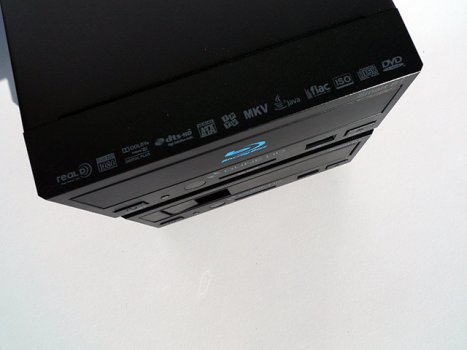 The consistent playback performance, stunning good looks, the promise of both internal upgradeability and external extensibility and a two year warranty, we really can’t think of a reason why the Smart Series shouldn’t be on your (very) short list for your next media playback system.
The consistent playback performance, stunning good looks, the promise of both internal upgradeability and external extensibility and a two year warranty, we really can’t think of a reason why the Smart Series shouldn’t be on your (very) short list for your next media playback system.
The entire Dune Smart Series is available now with the recommended retail price for the head units starting at $239US for the Smart H1, $255US for the Smart D1 and $299 for the Bluray packing Smart B1.
The (untested) Smart ME extension unit is priced at $79US, while the Smart HE hard drive extension is priced at $89. The Smart BE Bluray extension unit will set you back $159US
For more information and where to purchase these neat boxes, surf on over to HDi Dune’s website.
Considering the Series overall performance (and did we mention their good looks?) we have no hesitation in giving this series our coveted Editor’s choice award.
Our Rating: 9.5/10



